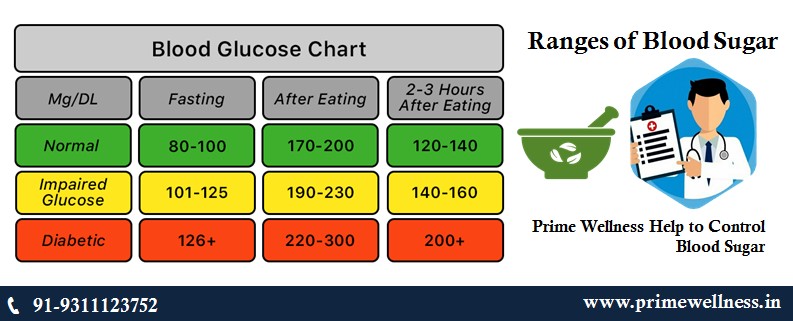
Ranges of Blood Sugar
Understanding blood glucose ranges is an important part of diabetes self-management.
This page provides 'normal' blood sugar ranges as well as blood sugar ranges for adults and children with type 1 diabetes, type 2 diabetes, and blood sugar ranges to determine diabetes in people.
If a diabetic has a metre, test strips, and is testing, it is critical to understand what the blood glucose level means.
Recommended blood glucose levels vary depending on the individual, and you should discuss this with your healthcare team.
In addition, during pregnancy, women may be given target blood sugar levels.
Ranges of recommended target blood glucose levels
The NICE recommended target blood glucose levels for adults with type 1 diabetes, type 2 diabetes, and children with type 1 diabetes are listed below.
Furthermore, the International Diabetes Federation's target ranges for people who do not have diabetes are stated.
The table serves as a general guide. You should aim for an individual target set by your healthcare team.
NICE recommended target blood glucose level ranges
|
Target Levels |
Upon waking |
Before meals |
At least 90 minutes after meals |
|
Non-diabetic* |
4.0 to 5.9 mmol/L |
under 7.8 mmol/L |
|
|
Type 2 diabetes |
4 to 7 mmol/L |
under 8.5 mmol/L |
|
|
Type 1 diabetes |
5 to 7 mmol/L |
4 to 7 mmol/L |
5 to 9 mmol/L |
|
Children w/ type 1 diabetes |
4 to 7 mmol/L |
4 to 7 mmol/L |
5 to 9 mmol/L |
Blood sugar levels in normal and diabetic people
Normal blood sugar levels for the vast majority of healthy people are as follows:
- When fasting, 4.0 to 5.4 mmol/L (72 to 99 mg/dL) [361]
- 7.8 mmol/L (140 mg/dL) and higher 2 hours after consuming
- Diabetes patients should aim for the following blood sugar levels:
4 to 7 mmol/L before meals for people with type 1 or type 2 diabetes
After meals, people with type 1 diabetes should have less than 9 mmol/L and people with type 2 diabetes should have less than 8.5 mmol/L.
Blood sugar levels used to diagnose diabetes.
The following table lays out the criteria for diagnoses of diabetes and prediabetes.
Blood sugar levels in diagnosing diabetes
|
Plasma glucose test |
Normal |
Prediabetes |
Diabetes |
|
Random |
Below 11.1 mmol/l |
N/A |
11.1 mmol/l or more |
|
Fasting |
Below 5.5 mmol/l |
5.5 to 6.9 mmol/l |
7.0 mmol/l or more |
|
2 hour post-prandial |
Below 7.8 mmol/l |
7.8 to 11.0 mmol/l |
11.1 mmol/l or more |
Plasma glucose test at random
A blood sample can be taken at any time for a random plasma glucose test. Because it requires less planning, it is used in the diagnosis of type 1 diabetes when time is of the essence.
Fasting plasma glucose measurement
A fasting plasma glucose test is performed after at least eight hours of fasting and is thus typically performed in the morning.
A fasting plasma glucose result of 5.5 to 6.9 mmol/l, according to NICE guidelines, puts someone at a higher risk of developing type 2 diabetes, especially when combined with other risk factors for type 2 diabetes.
Test for Oral Glucose Tolerance (OGTT)
- An oral glucose tolerance test begins with a fasting blood sample, followed by a very sweet drink containing 75g of glucose.
- After drinking this, you must rest for 2 hours before another blood sample is taken.
- Diabetes is diagnosed using the HbA1c test.
- An HbA1c test does not directly measure blood glucose levels; however, the results are influenced by how high or low your blood glucose levels have tended to be over the previous 2 to 3 months.
Diabetes or prediabetes is indicated by the following conditions:
- Normal: less than 42 mmol/mol (6.0%)
- Prediabetes: 42 to 47 mmol/mol (6.0 to 6.4 percent)
- Diabetes: 48 mmol/mol (6.5% or over)
Why is maintaining healthy blood sugar levels important?
It is critical that you keep your blood glucose levels as stable as possible, as having high sugar levels for extended periods of time increases the risk of diabetes complications developing.
Diabetes complications are health issues such as
- kidney disease
- Nerve damage.
- Retinal disorder
- Stroke
- Heart disease
This list of problems may appear frightening, but the important thing to remember is that the risk of these problems can be reduced by maintaining proper blood glucose levels. Small improvements can add up to big results if you stay committed and maintain them on most days.






